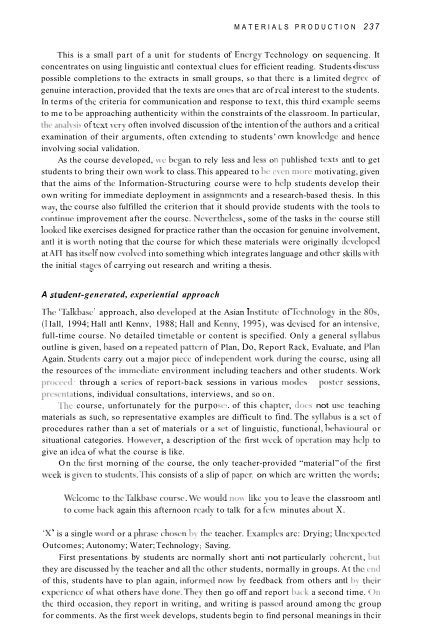Download - Search
Download - Search
Download - Search
You also want an ePaper? Increase the reach of your titles
YUMPU automatically turns print PDFs into web optimized ePapers that Google loves.
1 throughMATERIALS PRODUCTION 237This is a small part of a unit for students of Encrgy Tcchnology on sequencing. Itconcentrates on using linguistic antl contextual clues for efficient reading. Students discusspossible completions to the extracts in small groups, so that there is a limited tlegrcc ofgenuine interaction, provided that the texts are ones that arc of real interest to the students.In terms of the criteria for communication and response to text, this third example seemsto me to lie approaching authenticity within the constraints of the classroom. In particular,of text very often involved discussion of the intention ofthe authors and a criticalexamination of their arguments, often cxtcnding to students’ o\vn knowledge and henceinvolving social validation.As the course developed, we began to rely less and less o uhlishcd texts antl to getstudents to bring their own work to class. This appeared to lie> more motivating, giventhat the aims of the Information-Structuring course were to help students develop theirown writing for immediate deployment in assignmcnts and a research-based thesis. In thishvay, the course also fulfilled the criterion that it should provide students with the tools tocontinue improvement after the coursc. Ncverthclcss, some of the tasks in the course stilllooked like exercises designed for practice rather than the occasion for genuine involvement,antl it is \vorth noting that the course for which these materials were originally developedat All‘ has itself now cvolved into something which integrates language and other skills \viththe initial stages of carrying out research and writing a thesis.A studen t-generated, experiential approachThe ‘Talkbase’ approach, also tleveloped at the Asian Institutc of Tcchnology in the 8Os,(I Iall, 1994; Hall antl Kennv, 1988; Hall and Kenny, 1995), was devised for an intensi\,e,full-time course. No detailed timetal>le or content is specified. Only a general syllaliusoutline is given, Iiased on a repeatcd pattern of Plan, Do, Report Rack, Evaluate, and PlanAgain. Studcnts carry out a major piece of intlcpentlent Lvork during the coursc, using allthe resources of the immcdiatc environment including teachers and other students. Worka series of report-back sessions in various modes poster sessions,tions, individual consultations, interviews, and so on.‘l.he course, unfortunately for the purpo . of this chaptcr, does not use teachingmaterials as such, so representative examples are difficult to find. The syllahus is a set ofprocedures rather than a set of materials or a set of linguistic, functional, Iiehavioural orsituational categories. Hohvever, a description of thc first week of opcration may help togive an idea ofwhat the course is like.On the tirst morning of the course, the only teacher-provided “material” ot’the firstwcck is given to studcnts.’l’his consists of a slip of paper, on which arc written the lvortls:Wclcomc to thcTalklmw courw. We mould no\\ like >ou to lea\? the classroom antlto Lome hack again this afternoon ready to talk for a fcn minutes aliout X.‘X’ is a single wort1 or a phrase chosen by the teacher. Examples arc: Drying; UncxpcctcdOutcomes; Autonomy; Water; Technology ; Saving.First presentations by students arc normally short anti not particularly coherent, butthey are discussed by the teacher and all the other students, normally in groups. At the endof this, students have to plan again, informed nolv hy feedback from others antl hy thcirexperiencc ol‘\vhat others hale tlone.They then go off and report hack a second time. 011the third occasion, thcy report in writing, and writing is passcd around among the groupfor comments. As the first lveek develops, students begin to find personal meanings in thcir


